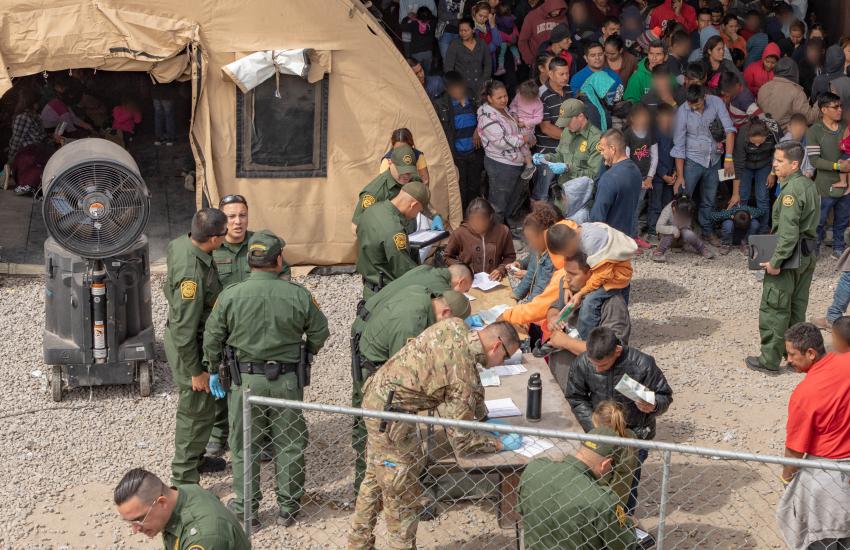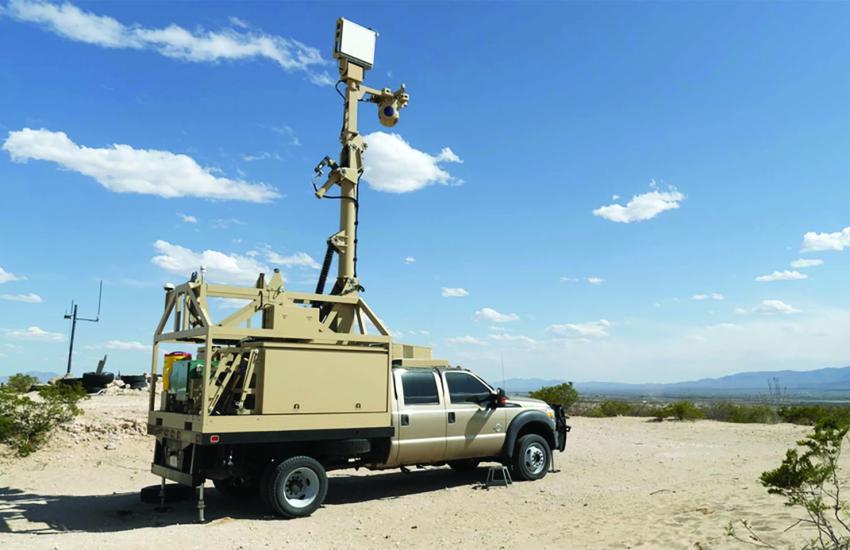New Tools Protect Increasingly Complicated Border
The U.S.-Mexico border poses a growing security challenge, including an evolution toward cartel-waged electronic warfare, that demands new technological capabilities, experts say.
U.S. Customs and Border Protection (CBP) is quickly adopting various innovations to enhance its enforcement.
“CBP is surging resources and increasing efficiency, prioritizing smart border security solutions, making historic investments in technology, taking the fight to cartels and smugglers and doing more with our regional partners than ever before through a combination of technology, infrastructure, personnel and other enforcement solutions to ensure our border remains secure,” a CBP spokesperson told SIGNAL Media.
The large investment in border technologies saved over 70,000 hours of agent time, the CBP claimed.
Among the new initiatives, one seeks to make the presence of CBP officers less predictable to potential offenders.
“We have a program that we were awarded called ARST, which is Autonomous Relocatable Surveillance Tower,” said Mike Powell, director of business development innovation solutions at Elbit Systems of America, a company that supplies a variety of border surveillance technologies.
Powell described the CBP’s latest program as an attempt to address evolving challenges. Currently, human smugglers and drug traffickers move away from towers and toward areas with little or no surveillance. Therefore, mobile platforms are the next step in the cat-and-mouse encounters.
“The concrete reality is that there are thousands of people who cross the border, the U.S. and Mexico border,” said Karine Côté-Boucher, associate professor of criminology at the University of Montreal.
In 2022, the CBP encountered 2,378,944 migrants at the southwest land border. This number includes single adults, individuals in a family unit, accompanied minors and unaccompanied children.
The CBP figure represents 0.85% of the world’s total of 281 million migrants, according to the United Nation’s International Organization for Migration.
“On a global scale, what’s happening in the U.S. is not that big,” said Côté-Boucher, speaking about worldwide immigration. Nevertheless, the problem at the border is larger than immigration.
In 2022, 288,000 pounds of drugs were seized at the southwest land border, giving traffickers an opportunity to hide in lawful traffic and migration, according to the same agency.
The 2023 government budget is allocating $15.3 billion for the CBP and $8.1 billion to immigration law enforcement. These figures include $309 million for border security technology.
Barriers and facilities populate the area between both countries, and technologies are an increasingly important piece of the enforcement puzzle.
There are two main sources of experience when deploying new tools in this area. One comes from adapted U.S. armed services technology and the other comes from the Gaza-Israeli border. Terrorists’ attack methods are comparable to those employed by criminals trying to smuggle substances into the United States.
Meanwhile, innovations once reserved for warfighters find a space along the line that separates the two countries.
“Where we become a lot more valuable is when you do [surveillance] and [transport], we can do a gimbal and have surveillance, but we can also have a drop mechanism to where we can supply, either troops or people in the field, with any type of supplies that they might need,” said Jason Wright, senior program manager, Small Unmanned Aerial Division at AeroVironment.
Wright explained how his unmanned aerial vehicle (UAV) is used by authorities on the border to keep an eye on activities and potentially deliver supplies to enforcers.
Wright’s company presented a Vapor UAV that can carry up to 20 pounds, enough to equip the drone with a surveillance camera and other payloads. The version the CBP employs was designed for the U.S. Army, and its updated version is better adapted for missions at the border, according to Wright.
The helicopter can transport a variety of payloads, including ammunition or crowd control measures. If the right add-ons are attached, the UAV can potentially deploy gas or smoke canisters.
“If the customer wanted to have, say, gas or something of that nature, or a smoke grenade or something like that, it could actually drop from the helicopter to help with those types of situations,” Wright said.
The company has a wide range of products, many of them even supporting Ukrainians in their war, according to AeroVironment’s webpage.
And as the company’s products face increasing technological challenges in conflict areas around the world, the industry also sees nonstate actors upping the electronic warfare game in the border area.
“When you have a video feed going back and forth and you lose your radio, you’re losing that downlink and you’re not able to receive that video anymore, so to be able to have that strength in your video is really a big deal when you’re out there trying to control the border,” Wright told SIGNAL Media in an interview.
While the company was clear that at no point had border actors successfully jammed an AeroVironment product, the jamming of some drones does happen, and the company considered these potential jamming hazards in the product updates. Features like autonomous control in case radio signals are jammed are included in the new versions, according to Wright.
“Flying with the loss of [GPS] and the loss of radios, so being able to have both of those systems go out and still be able to complete a mission is something that the entire industry is struggling to be able to do, and we plan on having that in our road map in the next year,” Wright said.
The company has received orders from six customers, including the Department of Defense and the Department of Homeland Security, and expects to have dozens of units in the skies above law enforcers and troops.
The company’s revenues in 2022 were $446 million, and its small drones business unit accounted for 40% of those, according to its annual report; 58% of sales went to U.S. federal government agencies.
Elbit Systems, which has so far deployed 55 integrated fixed towers, covering over 200 miles of the U.S. southern border, prides itself on handling data to ease operations for border agents. One growing danger is in small drones presumably operated by nonstate actors to guide traffickers of people and narcotics.
“Back in 2018, we didn’t nearly have the rise in awareness of just how big this problem of counter-drone solutions would be, or drones that represent a threat, but we knew it was coming. We made a strategic decision to invest in AI (artificial intelligence) R&D (research and development) in the development of the new radar,” Elbit’s Powell told SIGNAL Media in an interview.
During a recent demonstration in El Paso, Texas, Powell relayed a discussion he’d had with border officials, and the company was faced with a real-world situation.
“The [drug] cartel is using 250-gram drones to ISR (Intelligence Surveillance Reconnaissance) to death. The cartel knows everything that’s happening on the U.S. southern border, in key areas, by using these small drones with 4K cameras. The drones are the size of a typical cellphone,” Powell quoted, reminiscing about a conversation with officials.
“We’ve got all these radars that we’ve tested … we’re not detecting these [small drones], and we can’t mitigate this threat, and it’s a serious threat because they can see everything,” Powell added.


New radars can detect high-velocity small threats like those described, giving law enforcement an advantage when potential criminals are conducting ISR to find the best roads into the United States.
Towers, conceived by the company along the Gaza-Israel border, include an array of sensors. Another tool is video, coupled with AI and machine learning (ML) algorithms.
“Video is the most popular, and the capabilities that exist within AI/ML,” Powell said. “We have advanced AI-ML organization … it is crazy powerful for taking all this data and finding a signal out of the noise.”
Powell explained that Elbit’s ground and tower sensors can detect movement at precise locations to later acknowledge individuals or groups migrating near the border. Those areas may have lawful traffic, which amounts to most of what the algorithms must separate from potential law offenders.
These sensors can be included in a mobile unit, and the CBP is looking toward procuring these systems from many suppliers and deploying 500 of these units along the border.
Similar to Israel, underground tunnels continue to pose a serious threat to the U.S. border. Elbit Systems, an Israeli-originated company, refers to underground tunnel detection as being paramount to Israel’s security. “That technology has to work, and it does work,” Powell said. “And we’ve delivered technology that was developed for that purpose to address human and drug trafficking across the U.S. southern border. ... Team awareness kits, also known as TAK devices, much like Android phones, give agents a common operating picture for them to be able to assess and dispatch to given coordinates,” Powell explained.
“We’re working very closely with the organizations that are setting the requirements for meeting the future threats of counter drone, both air, ground and surface. We’re being encouraged to work with industry.” Powell explained that the CBP tries to incentivize cooperation among competitors to produce the most robust system with multiple capabilities.
Nevertheless, issues at the border are not only about unlawful activities, but also about people in need of help in one of the most inhospitable parts of the world.
“Strategically placed, advanced technology provides CBP staff with enhanced situational awareness and improves the ability of officers and agents to not only surveil, deter and detect individuals and contraband entering the United States illegally, but also to better identify those in need of rescue,” a CBP spokesperson said.
Still, as border law enforcement agencies improve their performance, there are unwanted consequences.
Social problems arise and these encourage more illegal migration, according to an expert.
“Too much border security increases irregular migrants in your country, and that has been in part proven for the past 15 years as the U.S. increased involvement and investments at the border, especially in terms of technologies, and made that border, therefore, more difficult to cross,” Côté-Boucher said.
Making the border less porous increases the presence of migratory workers—as especially those working in agriculture fear not being able to repeat the trip the next season and therefore choose to remain in the country, according to Côté-Boucher.
Another controversial intervention can be found around dozens of government departments, including law enforcement agencies in border areas that use simulators mimicking cellphone towers to trick phones in the area into transmitting their locations and identifying information. These could also gather information beyond the targeted suspect, including bystanders, according to a report by the American Civil Liberties Union, a nongovernmental organization (NGO).
Several organizations have been mentioned in reports as potential privacy violators. Although SIGNAL Media reached out to all organizations mentioned, they declined to comment or denied gathering this information.
Still, NGOs raise privacy concerns as immigrants’ cellphone data is presumably collected, geotracing and tracking immigrant movement. This data has appeared in a memorandum by The Heritage Foundation. Repeated attempts by SIGNAL Media to reach the think tank were unsuccessful.
As technologies adapt and improve their power to stop drug trafficking, the human side of the equation becomes more complicated, adding to technology’s impact upon lives on both sides of the border.





Comments